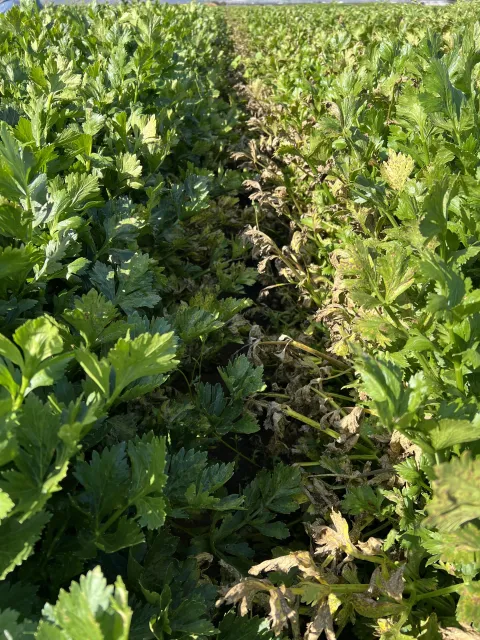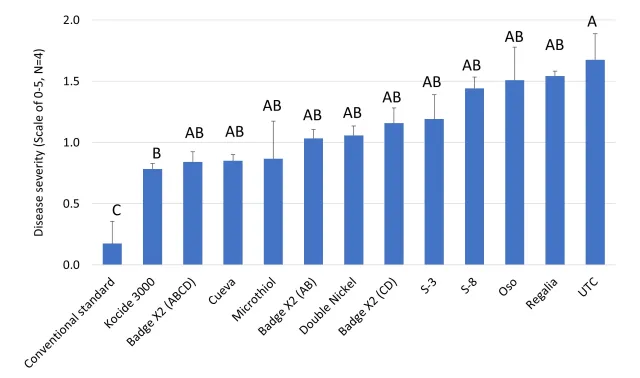Research update on organic fungicide evaluation for management of celery late blight
Yu-Chen Wang, Renée L. Eriksen, Chris Greer, and Alex Putman
Celery late blight can cause significant problems during the fall and spring production period in the Salinas and Santa Maria Valleys. The disease is caused by the fungus, Septoria apiicola. Early disease symptoms include small, irregularly shaped, chlorotic spots on the leaves and petioles. Older leaves and stalks are usually infected first. As the disease progresses, the lesions enlarge, later merge to blight large areas of tissue, leading to plant death (Photo 1). A characteristic feature of these lesions is the small, black round structures in the center (Photo 2). These structures are the reproductive bodies of the fungus, and the size and color are similar to black pepper.


Management. The primary source of the pathogen is contaminated celery seeds and undecomposed celery debris. Cultural controls include using pathogen-free seeds and rotating away from celery for more than 1 year. The disease is favored by cool temperatures and prolonged wetness from rain, dew, fog, and sprinkler irrigation. Dense crop canopies reduce air movement and can also increase disease development by prolonging leaf wetness periods. Fungal spores are spread by splashing water from rainfall or overhead sprinklers. Movement of equipment or workers can also spread the spores from diseased to healthy plants.
There are a number of fungicides that have activity against the disease. Apply protectant fungicides, especially if sprinkler irrigation is used or rain has occurred or is forecasted. Managing this disease in organic production is even more challenging as fungicide options are limited. The following section addresses research needs for organic management of celery late blight by evaluating the field efficacy of some organic fungicides.
Research update on organic fungicide evaluation.
A fungicide trial was conducted at the USDA-ARS Spence Road research farm to evaluate the efficacy of select organic fungicides for managing celery late blight in the summer of 2025. Celery ‘Sonora’ was transplanted on May 1. Eleven organic fungicide treatments, a standard conventional rotation treatment, and an untreated control (UTC) were arranged in a randomized complete block design with four replications (Table 1). Each 20 ft-long plot consisted of two lines of celery on a narrow bed (40-inch centers). Plant spacing was 7 inches. A buffer bed on either side of the plot was left untreated to ensure there was no drift between treatments. Septoria inoculum (1.4 x 105 spores/mL) was prepared by soaking and stirring dried infected celery leaves for 30 min in water then straining through two layers of cheesecloth. Inoculum was applied with a hand-pump backpack sprayer to all treatments on July 3 using a single hollow cone nozzle at 15 gal/A followed by light moistening the plant canopy. Fungicide treatments were applied with a CO2-pressurized backpack sprayer calibrated to deliver 35 gpa at 30 psi using TeeJet 8004E flat fan nozzles on a two-nozzle boom. Fungicide applications were made on June 10, June 26, July 10, and July 24. Initial celery late blight severity was evaluated on July 28 on 10 plants from the middle of each treatment plot based on a 0-5 rating scale (0=no symptoms, 1=1%-10% leaf blight, 2=10%-20% leaf blight, 3=20%-30% leaf blight, 4=30%-50% leaf blight, 5=petiole blight). The severity evaluation was made on an outer leaf, a middle leaf, and an inner leaf on each plant. Disease severity was expressed as the average rating of the 10 plants. Data were third root transformed, analyzed using analysis of variance (ANOVA), and the Tukey HSD test to separate means at P<0.05.
Results. Late blight was slow to develop after inoculation, but with the conducive environmental conditions created by overhead irrigation twice a week and adequate dew periods for sporulation and infection, disease severity was low to moderate near harvest maturity. On the July 28 rating date (88 days after planting), the average disease severity of the nontreated control was 1.7 (Fig. 1). There were significant differences in the average disease severity among treatments. All treatments reduced celery late blight disease severity numerically, but Kocide 3000 and the conventional fungicide rotation treatment had significantly lower celery late blight severity than the nontreated control. The conventional standard treatment had the lowest late blight severity and was therefore the most effective treatment against disease symptoms. Phytotoxicity was not observed with any treatment in this trial.
Table 1. Treatment list
| Product and rate/A | Active ingredient | OMRI listed | Application timingz |
| Untreated control | - | - | - |
Conventional standard Tilt (4 floz/acre) Bravo Weather Stick (3 pt/acre) |
Propiconazole Chlorothalonil | No |
AC BD |
| Badge X2 (3.57 lb/acre) | Copper oxychloride | Yes | ABCD |
| Badge X2 (3.57 lb/acre) | Copper oxychloride | Yes | AB |
| Badge X2 (3.57 lb/acre) | Copper oxychloride | Yes | CD |
| Cueva (2 gal/acre) | Copper octanoate | Yes | ABCD |
| Microthiol (6 lb/acre) | Sulfur | Yes | ABCD |
| Experimental: S-3 | Lipopeptide | - | ABCD |
| Experimental: S-8 | Lipopeptide | - | ABCD |
| Kocide 3000 (1.5 lb/acre) | Copper hydroxide | Yes | ABCD |
| Oso 5% (13 floz/acre) | Polyoxin D zinc salt | Yes | ABCD |
| Regalia (3 pt/acre) | Reynoutria sachalinensis plant extract | Yes | ABCD |
| Double Nickel (6 qt/acre) | Bacillus amyloliquefaciens | Yes | ABCD |
zApplication timing: A=June 10, B=June 26, C=July 10, and D=July 24


